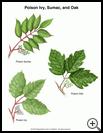
Poison Ivy, Poison Oak, and Poison Sumac: Teen Version
What is poison ivy, poison oak, and poison sumac?
Poison ivy, poison oak, and poison sumac are plants that are found throughout North America. Leaves, stems, roots and berries of all of these plants cause the same type of skin rash. More than 50% of people are sensitive to the oil of these plants.
The rash is very itchy and can have streaks or patches of redness and blisters on exposed body surfaces (such as the hands). The rash appears 1 or 2 days after you have been exposed to the plant in a forest or field.
How long does it last?
The rash usually lasts 2 weeks. Treatment reduces the symptoms but does not cure the rash.
How can I take care of myself?
- Wash the area
If you think you have had contact with one of these plants, wash the exposed areas of skin with any available soap for 5 minutes. Take special care to clean under your fingernails. Do this as soon as possible because after 1 hour it is too late to prevent the oil from absorbing into the skin.
- Cool soaks
Soak the area with the rash in cold water or massage it with an ice cube for 20 minutes as often as necessary. Let it air dry after the soaking or massage. This will reduce itching and oozing.
- Steroid creams
If applied early, a steroid cream can reduce the itching. Buy some nonprescription 1% hydrocortisone cream. Your provider may recommend a stronger prescription steroid cream.
The sores should be dried up and no longer itchy in 10 to 14 days. In the meantime, cut your fingernails short and try not to scratch the rash.
- Oral steroids
Severe or widespread poison ivy requires oral steroids to bring it under control. Take the medicine as prescribed by your doctor.
- Benadryl
If itching persists, take Benadryl orally (no prescription needed) 50 mg every 6 hours as needed.
- Contagiousness
The fluid from the sores themselves cannot spread the rash. However, oil or sap from the poisonous plant may stay on your pet's fur or on your clothes or shoes. This oil or sap remains as an irritant for about a week. Be sure to wash it off clothes or pets with soap and water.
How can I prevent the rash?
- Learn to recognize these plants. Poison ivy grows in all regions of North America. Poison oak grows in western North America and the southeastern region of the U.S. To be safe, avoid all plants with three large green leaves on each stem. Another clue is shiny black spots on damaged leaves. (The plant sap turns black when exposed to air.)
Poison sumac has 7 to 13 leaves per stem, grows in swamps in the southeast U.S., and is harder to recognize.
- Everyone should wear long pants or socks when walking through woods that may contain poison ivy, oak, or sumac. You may want to use a barrier skin cream such as IvyBlock, which is specifically made for this purpose.
When should I call my healthcare provider?
Call during office hours if:
- The itching becomes severe, even with treatment.
- The skin looks infected (you see pus or soft yellow scabs).
- The rash lasts longer than 2 weeks.
- You have other concerns or questions.
Last modified: 2009-11-23
Last reviewed: 2011-06-06

